Nursing Robots Market Size
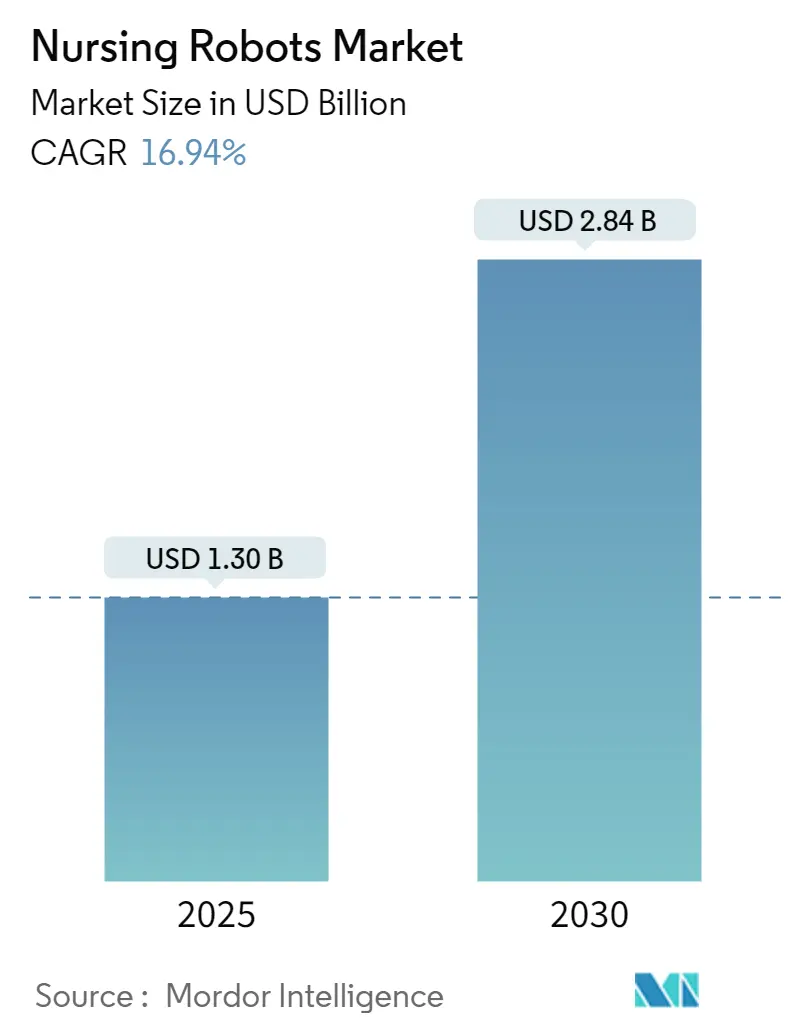
| Study Period | 2019 - 2030 |
| Market Size (2025) | USD 1.30 Billion |
| Market Size (2030) | USD 2.84 Billion |
| CAGR (2025 - 2030) | 16.94 % |
| Fastest Growing Market | Asia Pacific |
| Largest Market | North America |
| Market Concentration | High |
Major Players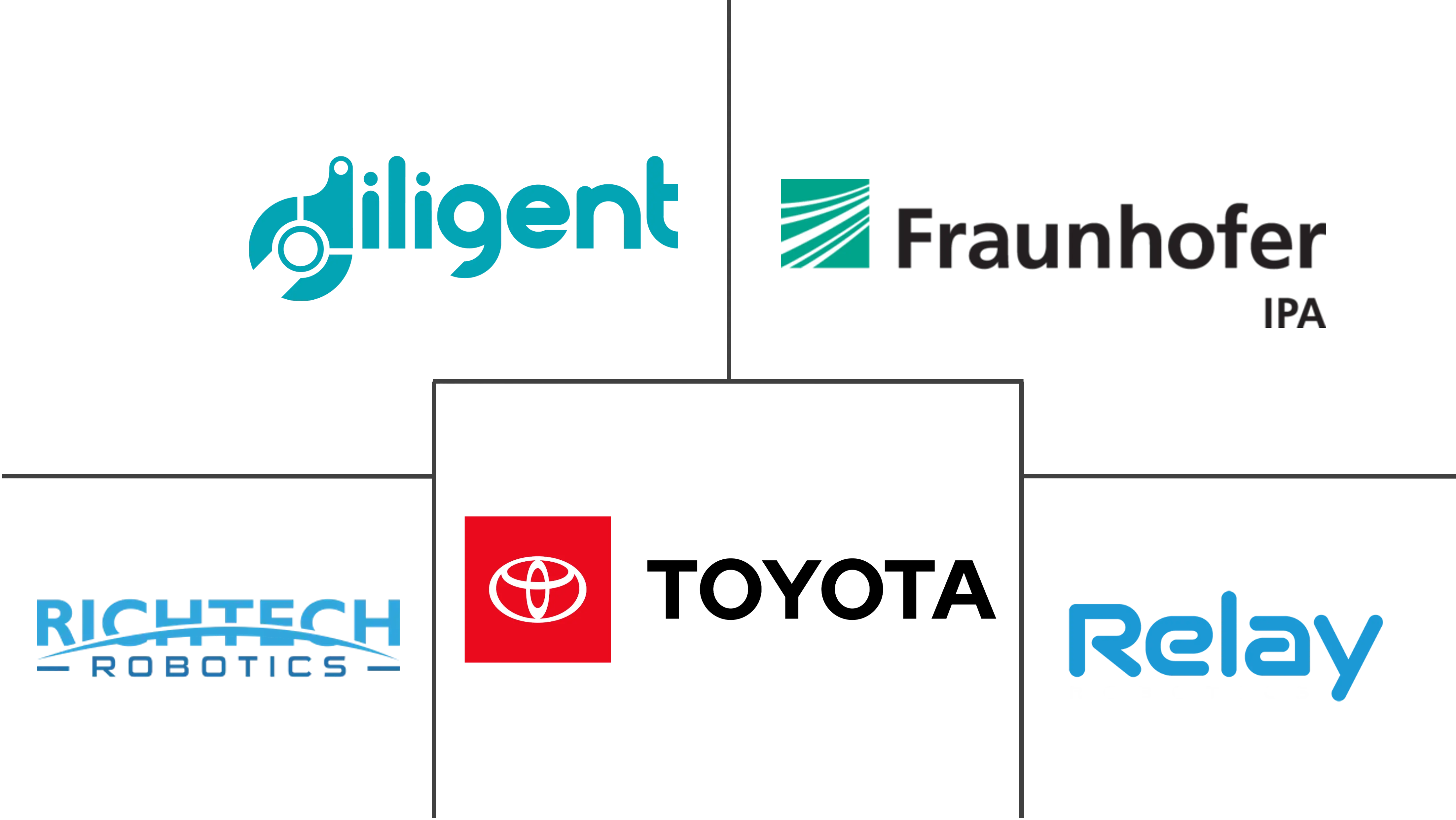
*Disclaimer: Major Players sorted in no particular order |
Nursing Robots Market Analysis
The Nursing Robots Market size is estimated at USD 1.30 billion in 2025, and is expected to reach USD 2.84 billion by 2030, at a CAGR of 16.94% during the forecast period (2025-2030).
Factors such as an increasing shortage of nursing staff coupled with a growing geriatric population, rising investment in the development of nursing robots, and technological advancements in robotics and artificial intelligence are expected to boost the growth of the nursing robots market during the forecast period.
The healthcare industry stands at a pivotal moment, grappling with a nursing shortage that jeopardizes patient care and further strains an already burdened system. For instance, the Nursing Shortage 2024 report revealed that over 60% of nurses in the United States reported feeling burnt out, with 22% having switched positions in the last six months. Furthermore, as of 2024, 47.8% of the US hospitals reported a vacancy rate exceeding 10%. Consequently, this nursing shortage across facilities is driving the rising demand for nursing robots, which is expected to fuel the market's growth.
Furthermore, in recent decades, Japan has increasingly embraced the use of robots in nursing homes. Initially brought in to handle routine tasks like lifting patients and dispensing medication, these robots have expanded their repertoire since then. They now offer companionship and entertainment, monitor vital signs, and even facilitate communication with healthcare professionals.
For instance, a May 2024 article published in Technology and Culture highlighted that the Japanese government is investing in the development of elder care robots. This initiative aims to counter a projected shortfall of 380,000 specialized personnel by 2025. Given these advancements and the aging population, robots are poised to play an even more pivotal role in Japan's nursing homes, addressing the increasing demand for elderly care services. This trend is expected to bolster the market's growth during the forecast period.
Moreover, technological advancements have positioned nursing robots as valuable partners in addressing understaffing and enhancing patient care in hospitals. With artificial intelligence (AI) demonstrating its reliability and effectiveness in clinical environments, hospitals are increasingly embracing nursing robotic solutions. This trend is driving a surge in demand for nursing robots, fueling the market's growth during the forecast period.
For instance, in June 2024, researchers from Tsinghua University introduced China’s first AI hospital, Agent Hospital. This pioneering establishment aims to transform healthcare through artificial intelligence. Agent Hospital features virtual doctors, nurses, and patients, all driven by advanced large language model (LLM) agents. These intelligent agents can replicate the complete diagnostic and treatment journey, enabling rapid and efficient patient care. Consequently, the rise of such AI-centric hospitals amplifies the demand for nursing robots, which specialize in patient monitoring and fundamental care. This trend underscores the growing allure of robotics in an increasingly tech-oriented healthcare landscape, further accelerating the market's growth.
Moreover, as hospitals increasingly conduct pilot programs for nursing robots, companies and researchers are being spurred to develop advanced nursing robots, driving the market's growth. For instance, in June 2023, Laakso Hospital in Finland initiated a three-month pilot program with a telerobot named Välkky. This robot has electronic skin technology, enabling it to transmit tactile sensations like pressure and vibration. Välkky's capabilities include handling patient meals, repositioning medical devices, and brushing hair. Such programs are poised to enhance the availability of nursing robots in hospitals, further propelling the market's growth during the forecast period.
Therefore, due to the shortage of nurses, increasing investment in the development of nursing robots, and the deployment of advanced nursing robots across hospitals, the studied market is expected to grow during the forecast period. However, the high cost of implementation, data privacy and security concerns, and stringent regulatory guidelines are likely to impede the market's growth during the forecast period.
Nursing Robots Market Trends
The Daily Care and Transportation Segment is Expected to Witness Significant Growth During the Forecast Period
Factors such as the increasing burden of chronic diseases, a growing aging population needing support for daily activities and transportation, advancements in nursing robotics, artificial intelligence, and sensor technology, and the rising adoption of nursing robots in healthcare settings are expected to drive the growth of the daily care and transportation segment.
Various studies have evaluated the effectiveness of transfer nursing robots in healthcare facilities. For instance, an April 2024 article published in Robotics and Autonomous Systems highlighted that transfer nursing robots have attracted notable attention due to challenges from an aging population and a caregiver shortage. These robots have proven effective and safe for moving elderly individuals or patients with mobility challenges, facilitating transfers between beds, wheelchairs, and operating tables. Such findings are poised to boost the demand for nursing robots in daily tasks and transportation, further fueling the segment's growth.
Research centers and robotic academies are increasingly focusing on developing advanced nursing robots capable of performing complex tasks, making them appealing in healthcare settings. For instance, in February 2024, the Frontier Research Center of Toyota Motor Corporation is developing a robot called Potaro that can transport medication instead of relying on human nurses to reduce their workload. Potaro handles an average of 170 transports per day and can operate in conjunction with over 200 cameras, elevators, doors, and other infrastructures. Potaro consists of a system built to assist Potaro in transporting smoothly by using ceiling cameras to check the situation in narrow corridors in advance. Thus, the development of such nursing robots that can transport large quantities of medicine for patients provides nurses time to interact as much with patients, hence bolstering the segment's growth.
Therefore, owing to the rising number of research studies evaluating the effectiveness of nursing robots in healthcare facilities and the adoption of nursing robots across hospitals and technology advancements, the studied segment is expected to grow during the forecast period. Domestic Ambidextrous Manipulator (ADAM) to assist people with basic daily tasks. ADAM is an indoor mobile robot and is capable of navigating around space and assisting with tedious or complicated domestic tasks such as carrying objects, moving furniture, pouring drinks, and preparing food. ADAM can work collaboratively with other robotic platforms by communicating with them for tasks where more than one robot is needed. It is designed to respond to a rapidly aging population, leveraging technological innovations to offer new levels of assistance to the elderly and infirm. Such technologically advanced daily care robots are expected to have a positive impact on the segment’s growth during the forecast period.
Therefore, owing to the rising number of research studies evaluating the effectiveness of nursing robots in healthcare facilities and the adoption of nursing robots across hospitals and technology advancements, the studied segment is expected to grow during the forecast period.
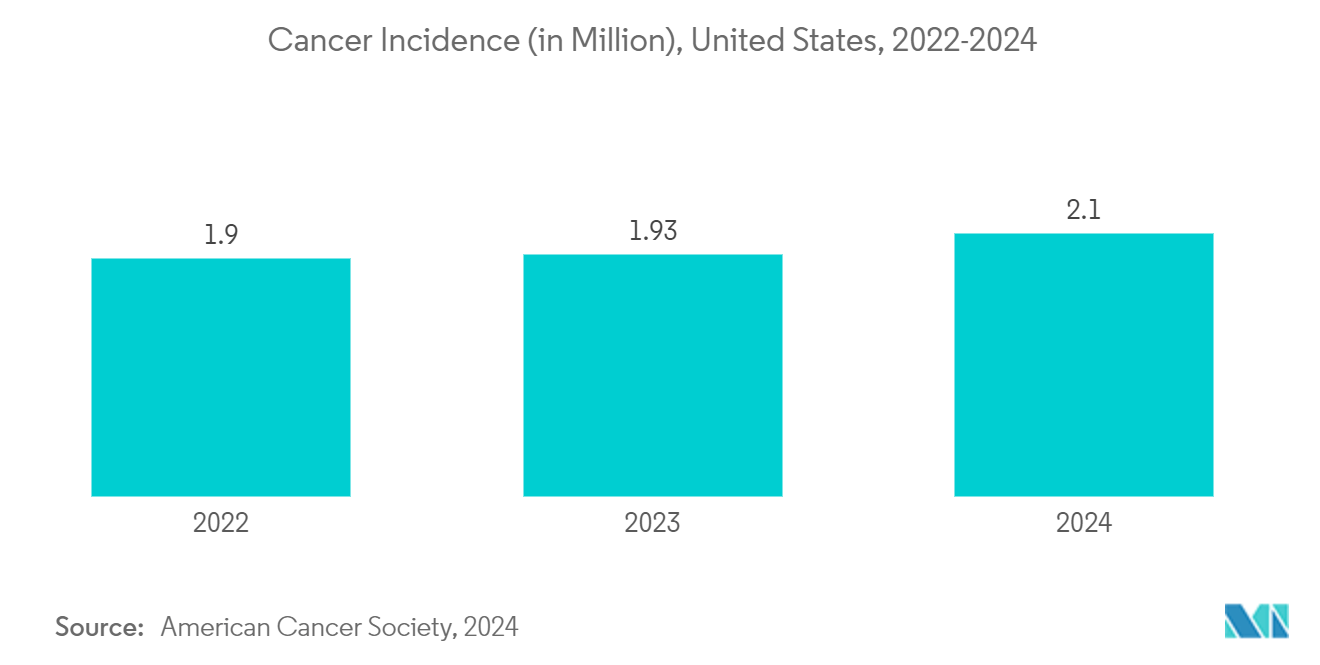
North America is Expected to Hold a Significant Share in the Market During the Forecast Period
North America is expected to witness significant growth in the nursing robots market. These factors include the growing aging population, ongoing shortages of healthcare professionals, especially nurses, across healthcare facilities, and rapid advancements in robotics, artificial intelligence, and automation technologies.
In addition, the presence of well-established healthcare infrastructure and spending, increasing investment in healthcare technology, and growing emphasis on patient experience and outcomes drive the integration of nursing robots in the region, further propelling the market's growth.
The deployment of nursing robots is expected to enhance the presence of advanced robotics in healthcare facilities in the region, driving the market's growth in the coming years. For instance, in October 2023, Lancaster General Hospital, a US-based hospital, introduced two nursing robots, Roxy and Rosie. These robots assist with routine non-clinical tasks, like picking up and delivering supplies, allowing nurses to concentrate on patient care. This adoption of nursing robots by hospitals highlights their increasing demand and signals a bullish trend for market expansion during the forecast period.
Similarly, in January 2023, MultiCare Health System, a not-for-profit American healthcare organization, unveiled four Moxi robot assistants. Moxi, equipped with an arm, gripper hand, and mobility features, adeptly transports lightweight medical resources, navigates hospital corridors, and delivers items to nurses and staff. The successful integration of such nursing robots in clinical environments underscores their efficacy, prompting other facilities to consider similar investments, thus driving the market's growth.
Moreover, robotics academies and research centers are intensifying their efforts to develop advanced nursing robots capable of executing intricate tasks, thereby boosting their desirability in healthcare. For instance, in June 2023, Relay Robotics Inc. unveiled its latest hospital robot, RelayRx, during the American Society of Health-System Pharmacists (ASHP) Summer Meetings and Exhibition. Relay robots efficiently handle deliveries across the facility, from pharmacies and labs to various departments. Such technologically advanced nursing robots are projected to positively influence the segment's growth in the coming years.
In conclusion, with the surge in nursing robot launches and continuous technological advancements in robotics, the market in North America is set for substantial growth during the forecast period.
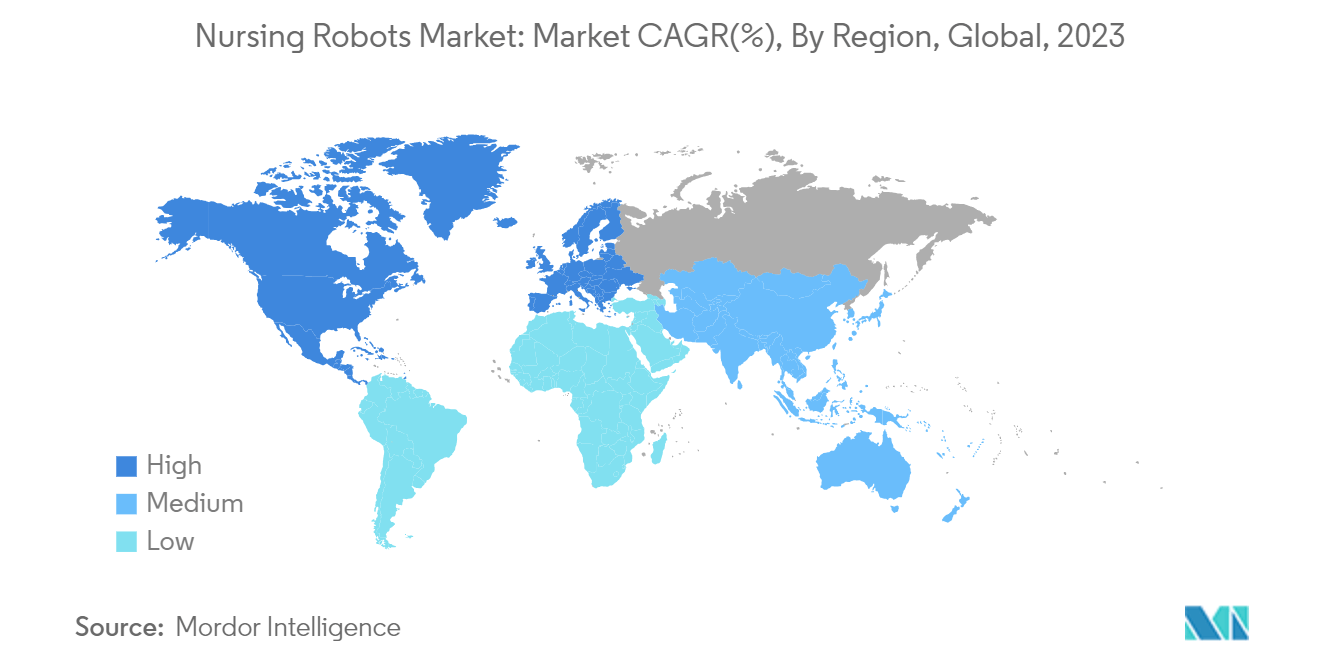
Nursing Robots Industry Overview
The nursing robots market is semi-consolidated owing to the presence of a large number of players. Key companies and researchers are focusing on the development of technologically advanced nursing robots for hospitals, which is expected to propel the demand for such robots in the market during the forecast period. Some of the key players in the market are Richtech Robotics Inc., Relay Robotics Inc., Diligent Robotics, Fraunhofer IPA, and Toyota Motor Corporation.
Nursing Robots Market Leaders
-
Richtech Robotics Inc.
-
Relay Robotics, Inc.
-
Diligent Robotics
-
Fraunhofer IPA
-
Toyota Motor Corporation
*Disclaimer: Major Players sorted in no particular order
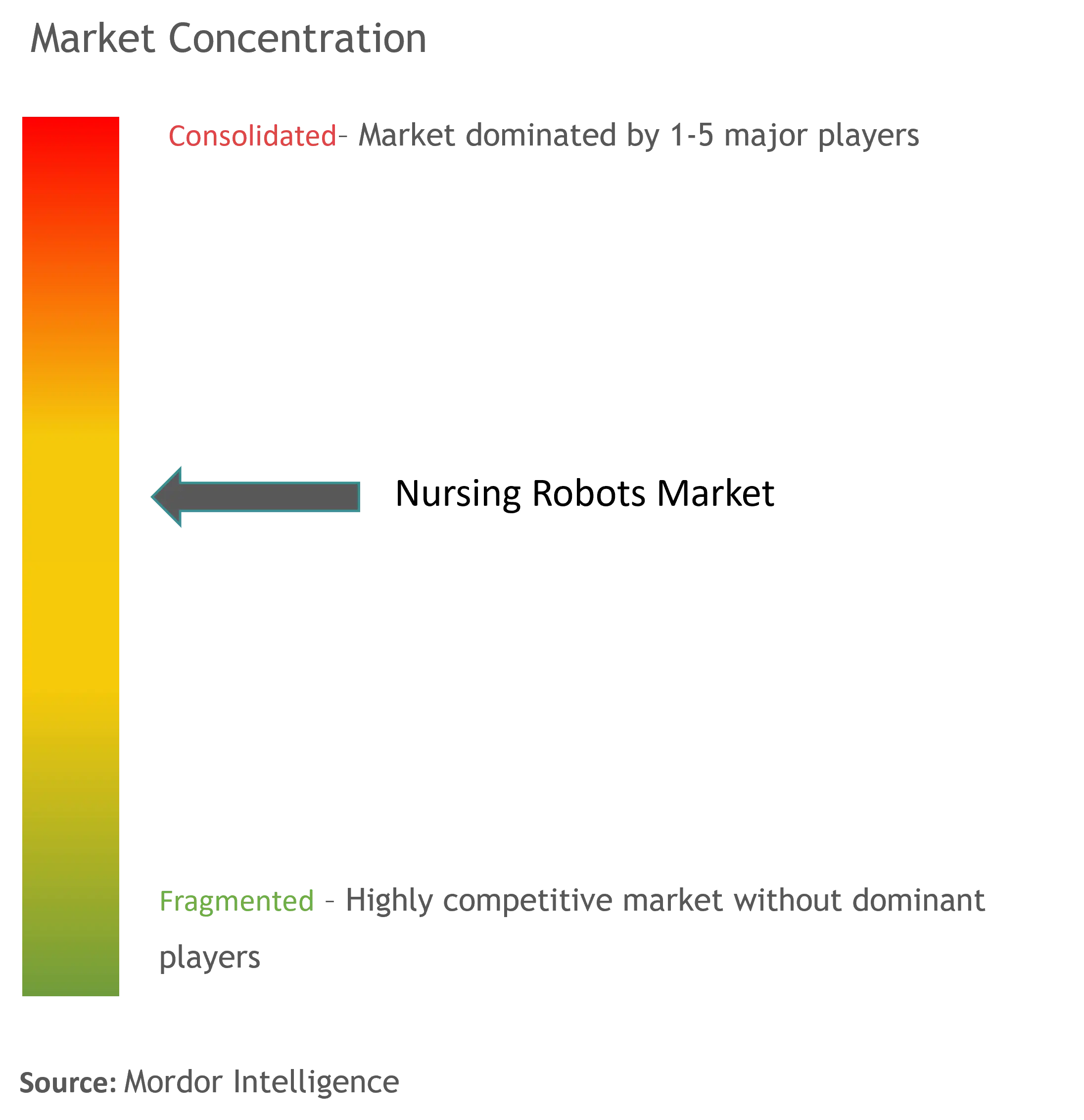
Nursing Robots Market News
- May 2024: Richtech Robotics Inc. introduced Medbot, an elevator delivery robot that is engineered to optimize pharmacy operations, ensuring round-the-clock, seamless medication delivery. By ensuring high operational accuracy, Medbot not only bolsters the efficiency of healthcare facilities through secure deliveries but also curtails operating costs and elevates the patient's experience. With the introduction of Medbot, hospitals and clinics enjoy a dependable, secure, and continuous service for their medication deliveries.
- March 2024: Rov Life, India, developed advanced humanoid robot nurses. These robots are equipped to monitor patients, dispense medications, and even perform basic diagnostics from a distance. This groundbreaking initiative significantly eases the burden on India's strained healthcare facilities and boosts healthcare access, especially in remote and underserved areas.
Nursing Robots Market Report - Table of Contents
1. INTRODUCTION
1.1 Study Assumptions and Market Definitions
1.2 Scope of the Study
2. RESEARCH METHODOLOGY
3. EXECUTIVE SUMMARY
4. MARKET DYNAMICS
4.1 Market Overview
4.2 Market Drivers
4.2.1 Increasing Shortage of Nursing Staff Coupled with Growing Geriatric Population
4.2.2 Rising Investment in the Development of Nursing Robots
4.2.3 Technological Advancements in Robotics and Artificial Intelligence
4.3 Market Restraints
4.3.1 High Cost of Implementation and Data Privacy and Security Concerns
4.3.2 Stringent Regulatory Guidelines
4.4 Porter's Five Forces Analysis
4.4.1 Threat of New Entrants
4.4.2 Bargaining Power of Buyers/Consumers
4.4.3 Bargaining Power of Suppliers
4.4.4 Threat of Substitute Products
4.4.5 Intensity of Competitive Rivalry
5. MARKET SEGMENTATION (Market Size by Value - USD)
5.1 By Product Type
5.1.1 Independent Support Robots
5.1.2 Daily Care and Transportation Robots
5.1.3 Medication Dispensing Robots
5.1.4 Other Product Types (Telepresence and Telemedicine Robots and Mobility Robots)
5.2 By End User
5.2.1 Hospitals and Clinics
5.2.2 Home Care Settings
5.2.3 Nursing Homes
5.2.4 Other End Users (Rehabilitation Centers and Senior Care Facilities)
5.3 Geography
5.3.1 North America
5.3.1.1 United States
5.3.1.2 Canada
5.3.1.3 Mexico
5.3.2 Europe
5.3.2.1 Germany
5.3.2.2 United Kingdom
5.3.2.3 France
5.3.2.4 Italy
5.3.2.5 Spain
5.3.2.6 Rest of Europe
5.3.3 Asia-Pacific
5.3.3.1 China
5.3.3.2 Japan
5.3.3.3 India
5.3.3.4 Australia
5.3.3.5 South Korea
5.3.3.6 Rest of Asia-Pacific
5.3.4 Middle East and Africa
5.3.4.1 GCC
5.3.4.2 South Africa
5.3.4.3 Rest of Middle East and Africa
5.3.5 South America
5.3.5.1 Brazil
5.3.5.2 Argentina
5.3.5.3 Rest of South America
6. COMPETITIVE LANDSCAPE
6.1 Company Profiles
6.1.1 Toyota Motor Corporation
6.1.2 Diligent Robotics
6.1.3 Hstar Technologies
6.1.4 SoftBank Robotics
6.1.5 Relay Robotics Inc.
6.1.6 Richtech Robotics Inc.
6.1.7 Fraunhofer IPA
6.1.8 RIKEN-SRK
6.1.9 Panasonic
6.1.10 Aethon
- *List Not Exhaustive
7. MARKET OPPORTUNITIES AND FUTURE TRENDS
Nursing Robots Industry Segmentation
As per the scope of the report, nursing robots are sophisticated robotic systems that aid healthcare professionals in delivering patient care. These robots undertake diverse tasks, including mobility assistance, bathing, dressing, and monitoring vital signs, aimed at boosting the efficiency and quality of healthcare services.
The nursing robots market is segmented into product type, end users, and geography. By product type, the market is segmented into independent support robots, daily care and transportation robots, medication dispensing robots, and other product types. By end user, the market is segmented into hospitals and clinics, home care settings, nursing homes, and other end users. By geography, the market is divided into North America, Europe, Asia-Pacific, Middle East and Africa, and South America. For each segment, the market sizes and forecasts were made based on value (USD).
| By Product Type | |
| Independent Support Robots | |
| Daily Care and Transportation Robots | |
| Medication Dispensing Robots | |
| Other Product Types (Telepresence and Telemedicine Robots and Mobility Robots) |
| By End User | |
| Hospitals and Clinics | |
| Home Care Settings | |
| Nursing Homes | |
| Other End Users (Rehabilitation Centers and Senior Care Facilities) |
| Geography | ||||||||
| ||||||||
| ||||||||
| ||||||||
| ||||||||
|
Nursing Robots Market Research FAQs
How big is the Nursing Robots Market?
The Nursing Robots Market size is expected to reach USD 1.30 billion in 2025 and grow at a CAGR of 16.94% to reach USD 2.84 billion by 2030.
What is the current Nursing Robots Market size?
In 2025, the Nursing Robots Market size is expected to reach USD 1.30 billion.
Who are the key players in Nursing Robots Market?
Richtech Robotics Inc., Relay Robotics, Inc., Diligent Robotics, Fraunhofer IPA and Toyota Motor Corporation are the major companies operating in the Nursing Robots Market.
Which is the fastest growing region in Nursing Robots Market?
Asia Pacific is estimated to grow at the highest CAGR over the forecast period (2025-2030).
Which region has the biggest share in Nursing Robots Market?
In 2025, the North America accounts for the largest market share in Nursing Robots Market.
What years does this Nursing Robots Market cover, and what was the market size in 2024?
In 2024, the Nursing Robots Market size was estimated at USD 1.08 billion. The report covers the Nursing Robots Market historical market size for years: 2019, 2020, 2021, 2022, 2023 and 2024. The report also forecasts the Nursing Robots Market size for years: 2025, 2026, 2027, 2028, 2029 and 2030.
Nursing Robots Industry Report
Statistics for the 2025 Nursing Robots market share, size and revenue growth rate, created by Mordor Intelligence™ Industry Reports. Nursing Robots analysis includes a market forecast outlook for 2025 to 2030 and historical overview. Get a sample of this industry analysis as a free report PDF download.



